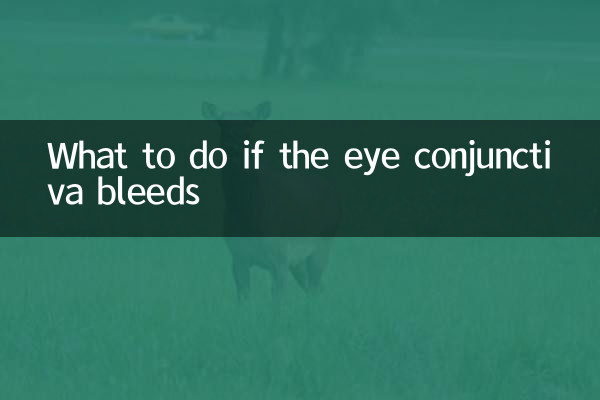What to do if the eye conjunctiva bleeds
Conjunctival hemorrhage is a common eye problem that usually appears as bright red blood spots in the white part of the eye. Although it looks scary, it is not serious in most cases. This article will give you a detailed introduction to the causes, symptoms, treatment methods and preventive measures of conjunctival hemorrhage to help you better deal with this problem.
1. What is conjunctival hemorrhage?

Conjunctival hemorrhage, also known as "subconjunctival hemorrhage," occurs when small blood vessels under the conjunctiva rupture and blood accumulates between the conjunctiva and sclera, forming bright red blood spots. Conjunctival hemorrhage usually does not affect vision, but may cause mild discomfort or a foreign body sensation.
2. Common causes of conjunctival hemorrhage
| Reason | Description |
|---|---|
| Trauma or eye rubbing | Rubbing the eyes vigorously or subjecting the eyes to external force may cause blood vessels to rupture. |
| high blood pressure | Elevated blood pressure may increase the risk of blood vessel rupture. |
| Severe coughing or sneezing | Sudden pressure changes can cause blood vessels in the eye to rupture. |
| eye surgery or infection | Certain eye surgeries or infections may also cause conjunctival bleeding. |
| Blood diseases or drug effects | Certain blood disorders or anticoagulant medications may increase the risk of bleeding. |
3. Symptoms of conjunctival hemorrhage
The main symptom of conjunctival hemorrhage is a bright red blood spot in the white part of the eye, which is usually not accompanied by pain or vision problems. Occasionally, patients may experience a slight foreign body sensation or discomfort.
| Symptoms | Description |
|---|---|
| Bright red blood spots on the white part of the eye | The most obvious symptoms usually resolve on their own without treatment. |
| Slight foreign body sensation | A small number of patients may experience mild discomfort. |
| No visual impact | Conjunctival hemorrhage usually does not affect vision. |
4. Treatment of conjunctival hemorrhage
Most conjunctival hemorrhages require no special treatment and the blood will absorb on its own within one to two weeks. Here are some suggested ways to deal with it:
| Treatment method | Description |
|---|---|
| cold compress | In the early stages of bleeding, cold compresses can be used to reduce swelling and discomfort. |
| avoid rubbing eyes | Reduce eye irritation and prevent bleeding from worsening. |
| Keep your eyes clean | Avoid infection, especially if the bleeding area is large. |
| Consult a doctor | If bleeding occurs repeatedly or is accompanied by other symptoms, seek medical attention promptly. |
5. How to prevent conjunctival hemorrhage?
The key to preventing conjunctival hemorrhage is to avoid behaviors and factors that can cause blood vessels to rupture:
| Precautions | Description |
|---|---|
| Avoid rubbing your eyes vigorously | Treat the eyes gently to reduce external stimulation. |
| control blood pressure | Patients with hypertension should monitor their blood pressure regularly to keep it stable. |
| Avoid severe coughing or sneezing | Seek medical treatment for respiratory illnesses if necessary. |
| Pay attention to eye protection | Wear goggles when exercising or working to prevent injuries. |
6. When do you need medical treatment?
Although most conjunctival hemorrhages do not require treatment, you should seek immediate medical attention if:
7. Conclusion
Conjunctival hemorrhage, although scary to look at, is usually harmless. You can better deal with this problem by understanding its causes and the correct ways to deal with it. If symptoms persist or worsen, it is recommended to seek medical attention promptly to ensure eye health.

check the details

check the details